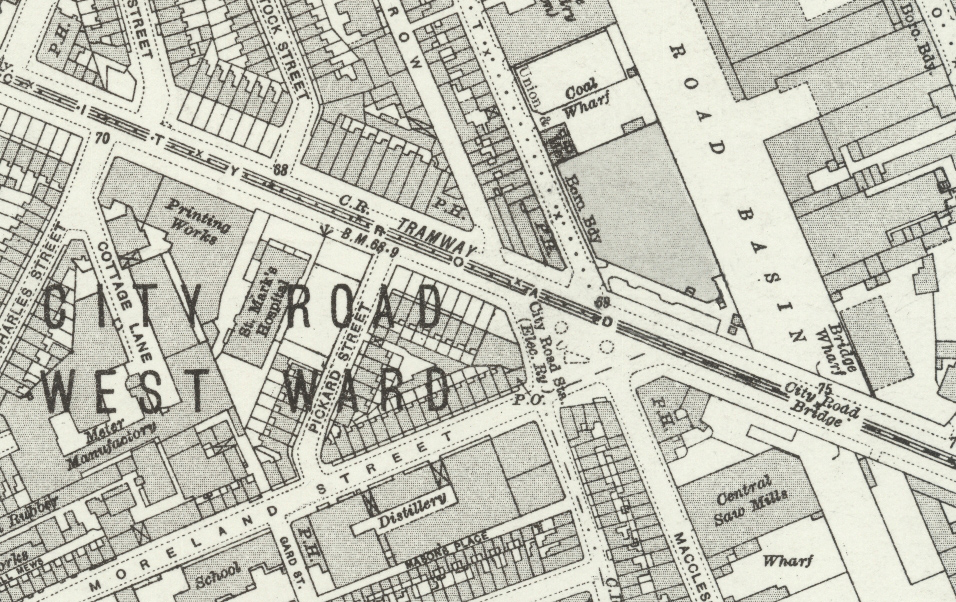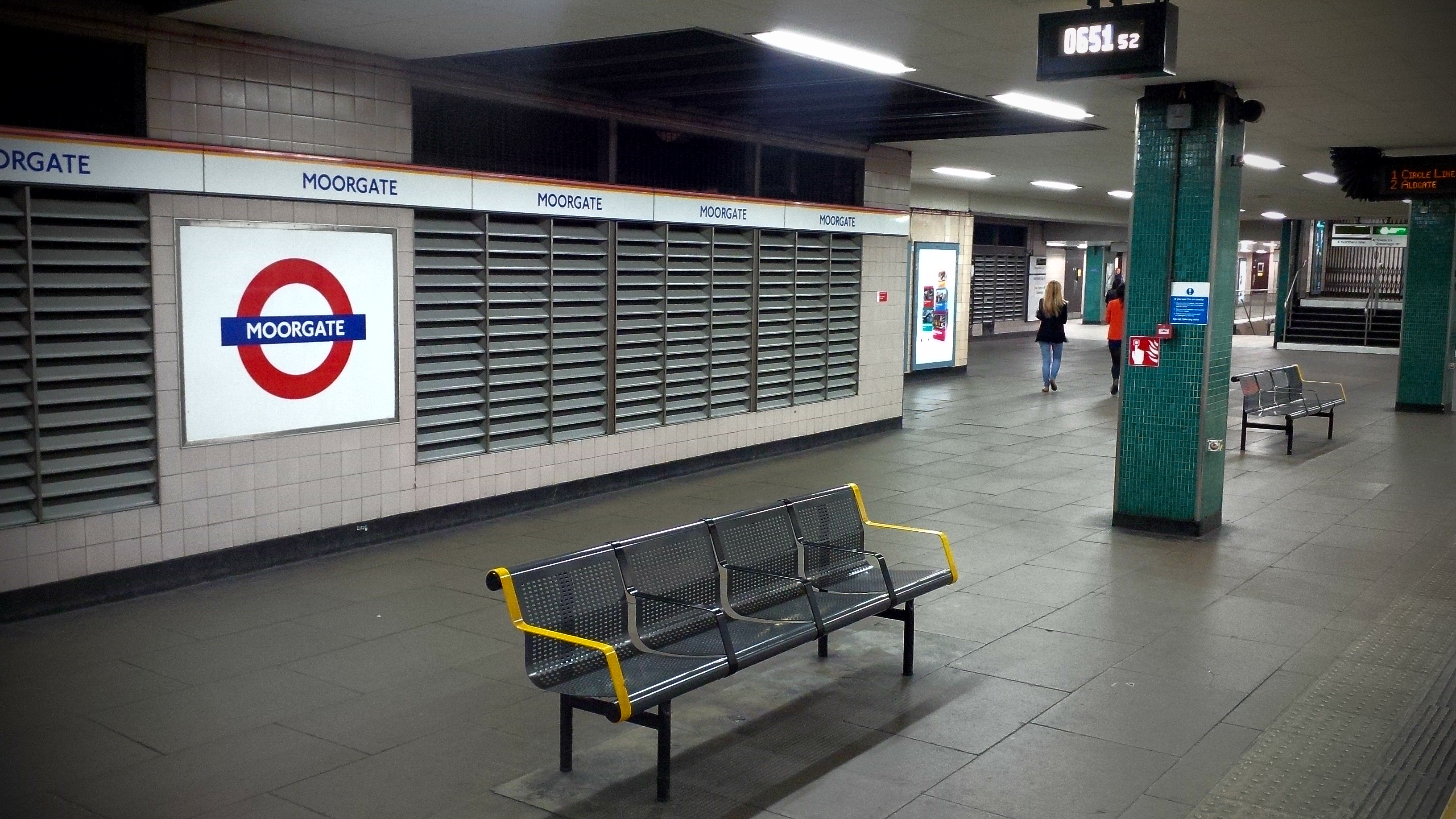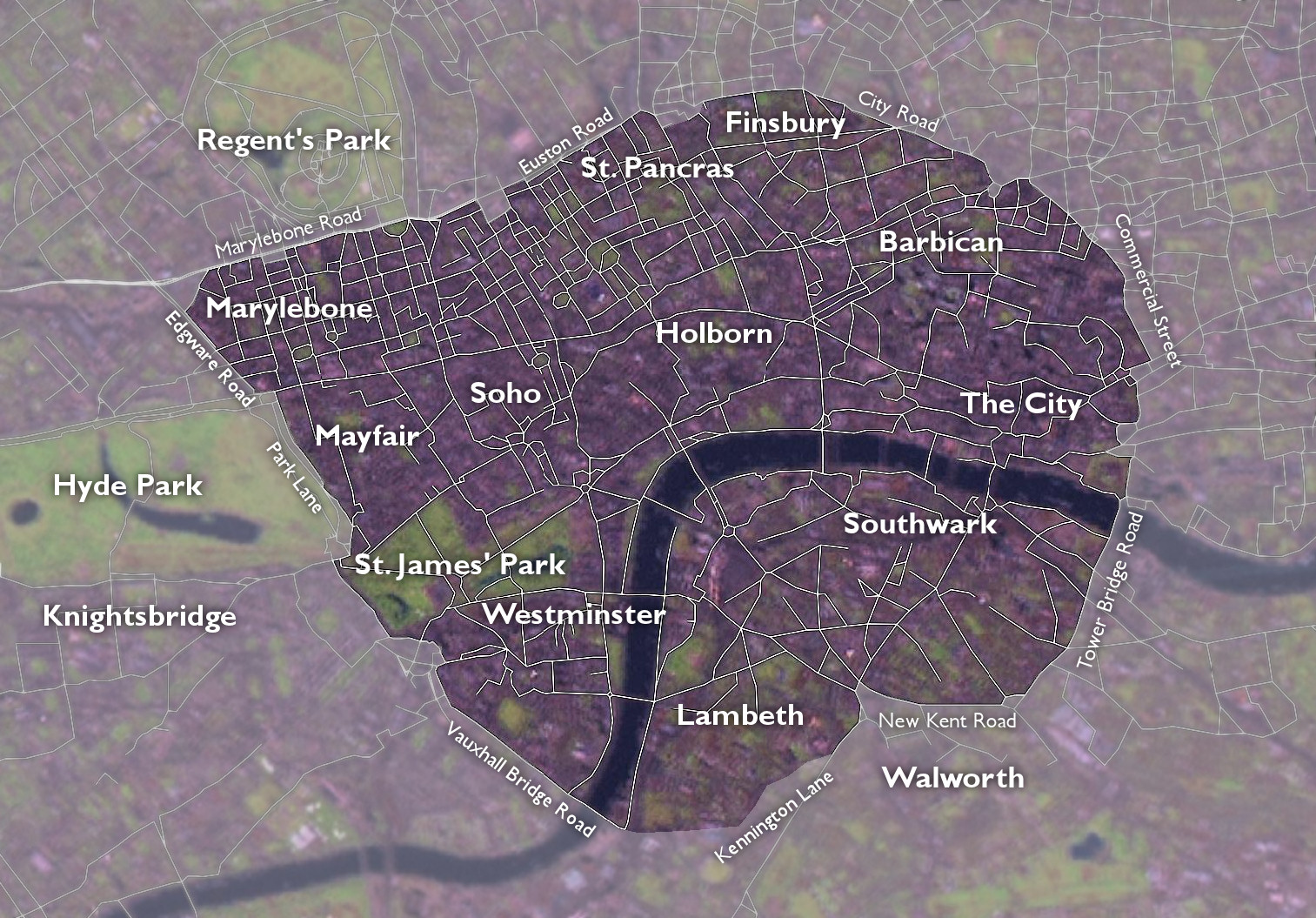|
City Road
City Road or The City Road is a road that runs through central London. The northwestern extremity of the road is at Angel where it forms a continuation of Pentonville Road. Pentonville Road itself is the modern name for the eastern part of London's first bypass, the New Road from Paddington to Islington, which was constructed in 1756. The City Road was built in 1761 as a continuation of that route to the City of London. From Angel, City Road runs roughly south-east and downhill past the City Road Basin of Regent's Canal and Moorfields Eye Hospital, after which it bears closer to south, and has a junction with Old Street at a large roundabout. After Old Street, it continues south, continuing past Bunhill Fields, Wesley's Chapel and the Honourable Artillery Company, after which the road continues south as Finsbury Square, then Finsbury Pavement, then Moorgate—the latter beginning at the border with the City of London. These roads form a major entry point into the City of L ... [...More Info...] [...Related Items...] OR: [Wikipedia] [Google] [Baidu] |
City Road Tube Station
City Road is a disused London Underground station in Islington, central London. It was opened in 1901 as part of the City & South London Railway's extension from Moorgate Street to Angel. City Road was situated between Old Street and Angel. The railway is now part of the Northern line. The station was closed in 1922 due to low passenger usage. The underground tunnels remain at track level, but the station remained derelict until the 1960s, when it was demolished except for the structure around the original lift shaft. This remained at City Road's junction with Central Street and Moreland Street until the late 2010s, when it was replaced by the Bunhill 2 Energy Centre. History From the start, City Road station was little used, and discussions of its closure were held as early as 1908: less than seven years after it was opened. The station was close to both Old Street and Angel, and was in a deprived area of Islington. However, City Road remained until 8 August 1922 when the Ci ... [...More Info...] [...Related Items...] OR: [Wikipedia] [Google] [Baidu] |
Pop Goes The Weasel
"Pop! Goes the Weasel" (Roud 5249) is a traditional English and American song, a country dance, nursery rhyme, and singing game that emerged in the mid-19th century. It is commonly used in Jack-in-the-box toys and for ice cream trucks. The song is honored annually on June 14 which is National Pop Goes the Weasel Day in the USA. Origin In the early 1850s, Miller and Beacham of Baltimore published sheet music for "Pop goes the Weasel for Fun and Frolic". This is the oldest known source that pairs the name to this tune. Miller and Beacham's music was a variation of "The Haymakers", a tune dating back to the 1700s. '' Gow's Repository of the Dance Music of Scotland'' (1799 to 1820), included "The Haymakers" as country dance or jig. One modern expert believes the tune, like most jigs, originated in the 1600s. In June 1852, the boat ''Pop Goes The Weasel'' competed in the Durham Regatta. By December 1852, "Pop Goes The Weasel" was a popular social dance in England. A ball held in ... [...More Info...] [...Related Items...] OR: [Wikipedia] [Google] [Baidu] |
Moorgate
Moorgate was one of the City of London's northern gates in its defensive wall, the last to be built. The gate took its name from the Moorfields, an area of marshy land that lay immediately north of the wall. The gate was demolished in 1762, but gave its name to a major street, ''Moorgate'', laid out in 1834. The area around the street and around Moorgate station is informally also referred to as ''Moorgate''. The Moorgate district is home to many financial institutions and has many notable historic and contemporary buildings. Moorgate station was the site of the Moorgate tube crash of 1975, when a Northern City Line train failed to stop and hit a brick wall killing 43. This resulted in systems, known as Moorgate control, being installed on the Underground in order to stop trains at dead-ends. The gate The earliest descriptions of Moorgate date from the early 15th century, where it was described as only a postern in the London city wall. Located between Bishopsgate and C ... [...More Info...] [...Related Items...] OR: [Wikipedia] [Google] [Baidu] |
Honourable Artillery Company Museum
The Honourable Artillery Company Museum opened in 1987 in Armoury House, City Road, London, England. It is associated with the Honourable Artillery Company, the oldest regiment in the British Army, which still maintains an active regiment as a core part of today's Army Reserve. History The museum was opened in 1987 when a large volume of archival material and militaria was sorted and put on display. It was re-opened by the Duke of Edinburgh on 12 October 2011, after a complete rebuild. The collection includes uniforms, armour, silver, medals and decorations, weapons, equipment and applied art. The archives date from 1537 and are of particular interest for 17th and 18th century militia and City of London matters. Entrance is free, although it is only open to the public by appointment. References Sources * External links Honourable Artillery Company website Museums established in 1987 Decorative arts museums in England Museum A museum ( ; plural museums or, rarely, ... [...More Info...] [...Related Items...] OR: [Wikipedia] [Google] [Baidu] |
Theatre Royal, Drury Lane
The Theatre Royal, Drury Lane, commonly known as Drury Lane, is a West End theatre and Grade I listed building in Covent Garden, London, England. The building faces Catherine Street (earlier named Bridges or Brydges Street) and backs onto Drury Lane. The building is the most recent in a line of four theatres which were built at the same location, the earliest of which dated back to 1663, making it the oldest theatre site in London still in use. According to the author Peter Thomson, for its first two centuries, Drury Lane could "reasonably have claimed to be London's leading theatre". For most of that time, it was one of a handful of patent theatres, granted monopoly rights to the production of "legitimate" drama in London (meaning spoken plays, rather than opera, dance, concerts, or plays with music). The first theatre on the site was built at the behest of Thomas Killigrew in the early 1660s, when theatres were allowed to reopen during the English Restoration. Initially ... [...More Info...] [...Related Items...] OR: [Wikipedia] [Google] [Baidu] |
Nursery Rhyme
A nursery rhyme is a traditional poem or song for children in Britain and many other countries, but usage of the term dates only from the late 18th/early 19th century. The term Mother Goose rhymes is interchangeable with nursery rhymes. From the mid-16th century nursery rhymes begin to be recorded in English plays, and most popular rhymes date from the 17th and 18th centuries. The first English collections, ''Tommy Thumb's Song Book'' and a sequel, ''Tommy Thumb's Pretty Song Book'', were published by Mary Cooper (publisher), Mary Cooper in 1744. Publisher John Newbery's stepson, Thomas Carnan, was the first to use the term Mother Goose for nursery rhymes when he published a compilation of English rhymes, ''Mother Goose's Melody, or, Sonnets for the Cradle'' (London, 1780). History Lullabies The oldest children's songs of which we have records are Lullaby, lullabies, intended to help a child fall asleep. Lullabies can be found in every human culture. The English term lullaby i ... [...More Info...] [...Related Items...] OR: [Wikipedia] [Google] [Baidu] |
Buses In London
Buses have been used as a mode of public transport in London since 1829, when George Shillibeer started operating a horse-drawn ''omnibus'' service from Paddington to the City of London. In the decades since their introduction, the red London bus has become a symbol of the city. , London has 675 bus routes served by over 8,700 buses, almost all of which are operated by private companies under contract to (and regulated by) London Buses, part of the publicly-owned Transport for London. Over 800 buses in the fleet are battery electric and hydrogen fuel cell buses, the 2nd largest zero emission bus fleet in Europe (behind Moscow). In 2006, London became one of the first major cities in the world to have an accessible, low floor bus fleet. History Buses have been used on the streets of London since 1829, when George Shillibeer started operating his horse-drawn ''omnibus'' service from Paddington to the City. In 1850, Thomas Tilling started horse bus services, and in 1855 ... [...More Info...] [...Related Items...] OR: [Wikipedia] [Google] [Baidu] |
Moorgate Station
Moorgate is a central London railway terminus and connected London Underground station on Moorgate in the City of London. Main line railway services for Hertford, Welwyn Garden City, Stevenage and Letchworth are operated by Great Northern, while the Underground station is served by the Circle, Hammersmith & City, Metropolitan and Northern lines. The station was opened as Moorgate Street in 1865 by the Metropolitan Railway. In 1900, the City & South London Railway added the station to its network, and the Great Northern & City Railway began serving the station in 1904. In 1975, the Northern City Line platforms were the site of the Moorgate tube crash – at the time, the worst peacetime accident in the history of the London Underground – in which 43 people were killed. Thameslink branch services were withdrawn in the early 21st century, and in 2022 a new ticket hall was built connected to the newly opened Elizabeth line at , with through access to the rest of Liverpool Str ... [...More Info...] [...Related Items...] OR: [Wikipedia] [Google] [Baidu] |
London Underground
The London Underground (also known simply as the Underground or by its nickname the Tube) is a rapid transit system serving Greater London and some parts of the adjacent ceremonial counties of England, counties of Buckinghamshire, Essex and Hertfordshire in England. The Underground has its origins in the Metropolitan Railway, the world's first underground passenger railway. Opened on 10 January 1863, it is now part of the Circle line (London Underground), Circle, District line, District, Hammersmith & City line, Hammersmith & City and Metropolitan lines. The first line to operate underground electric locomotive, electric traction trains, the City & South London Railway in 1890, is now part of the Northern line. The network has expanded to 11 lines, and in 2020/21 was used for 296 million passenger journeys, making it List of metro systems, one of the world's busiest metro systems. The 11 lines collectively handle up to 5 million passenger journeys a day and serve 272 ... [...More Info...] [...Related Items...] OR: [Wikipedia] [Google] [Baidu] |
London Borough Of Hackney
London is the capital and List of urban areas in the United Kingdom, largest city of England and the United Kingdom, with a population of just under 9 million. It stands on the River Thames in south-east England at the head of a estuary down to the North Sea, and has been a major settlement for two millennia. The City of London, its ancient core and financial centre, was founded by the Roman Empire, Romans as ''Londinium'' and retains its medieval boundaries.See also: Independent city#National capitals, Independent city § National capitals The City of Westminster, to the west of the City of London, has for centuries hosted the national Government of the United Kingdom, government and Parliament of the United Kingdom, parliament. Since the 19th century, the name "London" has also referred to the metropolis around this core, historically split between the Counties of England, counties of Middlesex, Essex, Surrey, Kent, and Hertfordshire, which largely comprises Greater London ... [...More Info...] [...Related Items...] OR: [Wikipedia] [Google] [Baidu] |
London Congestion Charge
The London congestion charge is a fee charged on most cars and motor vehicles being driven within the Congestion Charge Zone (CCZ) in Central London between 7:00 am and 6:00 pm Monday to Friday, and between 12:00 noon and 6:00 pm Saturday and Sunday. Inspired by Singapore's Electronic Road Pricing (ERP) system after London officials had travelled to the country, the charge was first introduced on 17 February 2003. The London charge zone is one of the largest congestion charge zones in the world, despite the removal of the Western Extension which operated between February 2007 and January 2011. The charge not only helps to reduce high traffic flow in the city streets, but also reduces air and noise pollution in the central London area and raises investment funds for London's transport system. The standard charge is £15, every day from 7:00 am to 6:00 pm, for each non-exempt vehicle driven within the zone, with a penalty of between £65 and £195 levied for non-payment. The ... [...More Info...] [...Related Items...] OR: [Wikipedia] [Google] [Baidu] |
London Inner Ring Road
The London Inner Ring Road, or Ring Road as signposted, is a route with an average diameter of formed from a number of major roads that encircle Central London. The ring road forms the boundary of the London congestion charge zone, although the ring road itself is not part of the zone. Starting at the northernmost point and moving clockwise, the roads defining the boundary are Pentonville Road, City Road, Old Street, Great Eastern Street, Commercial Street, Mansell Street, Tower Bridge, Tower Bridge Road, New Kent Road, the Elephant & Castle, Kennington Lane, the roads that constitute the Vauxhall Cross one-way system and Vauxhall Bridge, Vauxhall Bridge Road, the roads that constitute the Victoria one-way system, Grosvenor Place, Park Lane, Edgware Road, Old Marylebone Road, Marylebone Road and Euston Road. The route is described as the ''"Inner"'' Ring Road because there are two further sets of roads that have been described as London ring roads. The North and South Circ ... [...More Info...] [...Related Items...] OR: [Wikipedia] [Google] [Baidu] |







